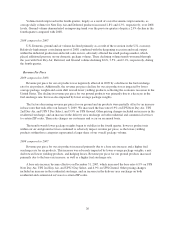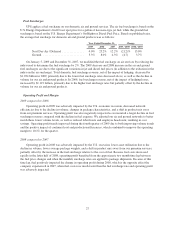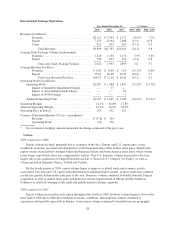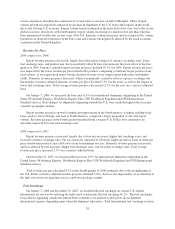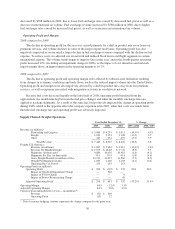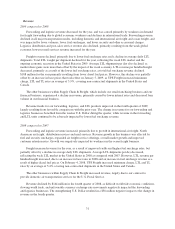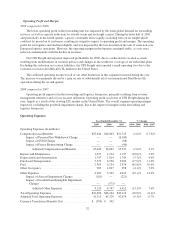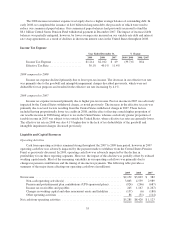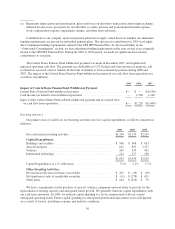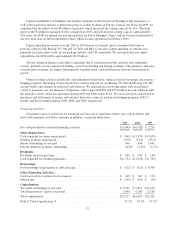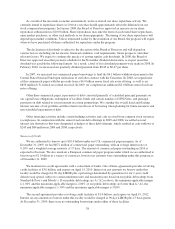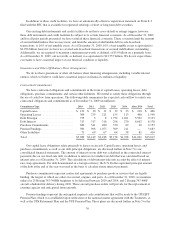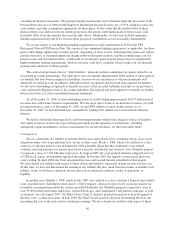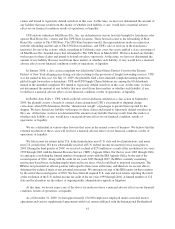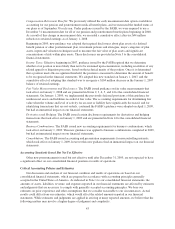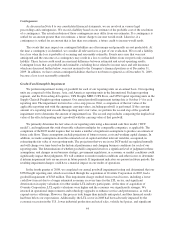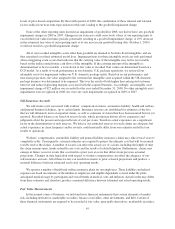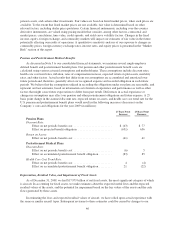UPS 2009 Annual Report Download - page 48
Download and view the complete annual report
Please find page 48 of the 2009 UPS annual report below. You can navigate through the pages in the report by either clicking on the pages listed below, or by using the keyword search tool below to find specific information within the annual report.
(a) Represents depreciation and amortization, gains and losses on derivative transactions and foreign exchange,
deferred income taxes, provisions for uncollectible accounts, pension and postretirement benefit expense,
stock compensation expense, impairment charges, and other non-cash items.
Contributions to our company-sponsored pension plans have largely varied based on whether any minimum
funding requirements are present for individual pension plans. The increase in contributions in 2009 was largely
due to minimum funding requirements related to the UPS IBT Pension Plan. As discussed further in the
“Contractual Commitments” section, we have minimum funding requirements in the next several years, primarily
related to the UPS IBT Pension Plan. During the 2007 to 2009 period, we made no significant discretionary
contributions to our plans.
The Central States Pension Fund withdrawal payment was made in December 2007, and significantly
impacted operating cash flow. The payment was deductible for U.S. Federal and state income tax purposes, and
we therefore received cash tax benefits in the form of refunds or lower estimated payments during 2008 and
2007. The impact of the Central States Pension Fund withdrawal payment on our cash flow from operations was
as follows (in millions):
2009 2008 2007
Impact of Central States Pension Fund Withdrawal Payment:
Central States Pension Fund withdrawal payment ............................. $— $ — $(6,100)
Cash income tax benefits from withdrawal payment ............................ — 1,228 1,100
Impact of the Central States Pension Fund withdrawal payment and associated taxes
on cash flow from operations ............................................ $— $1,228 $(5,000)
Investing Activities
Our primary uses of cash flows for investing activities were for capital expenditures, as follows (amounts in
millions):
2009 2008 2007
Net cash used in investing activities ............................ $1,248 $3,179 $2,199
Capital Expenditures:
Buildings and facilities ....................................... $ 568 $ 968 $ 853
Aircraft and parts ........................................... 611 852 1,137
Vehicles .................................................. 209 539 492
Information technology ...................................... 214 277 338
$1,602 $2,636 $2,820
Capital Expenditures as a % of Revenue ......................... 3.5% 5.1% 5.7%
Other Investing Activities:
Net (increase) decrease in finance receivables ..................... $ 261 $ (49) $ (39)
Net (purchases) sales of marketable securities ..................... $ (11) $ (278) $ 621
Other items ................................................ $ 104 $ (216) $ 39
We have commitments for the purchase of aircraft, vehicles, equipment and real estate to provide for the
replacement of existing capacity and anticipated future growth. We generally fund our capital expenditures with
our cash from operations. In 2009, we reduced capital spending to a level commensurate with our current
anticipated operating needs. Future capital spending for anticipated growth and replacement assets will depend
on a variety of factors, including economic and industry conditions.
36


